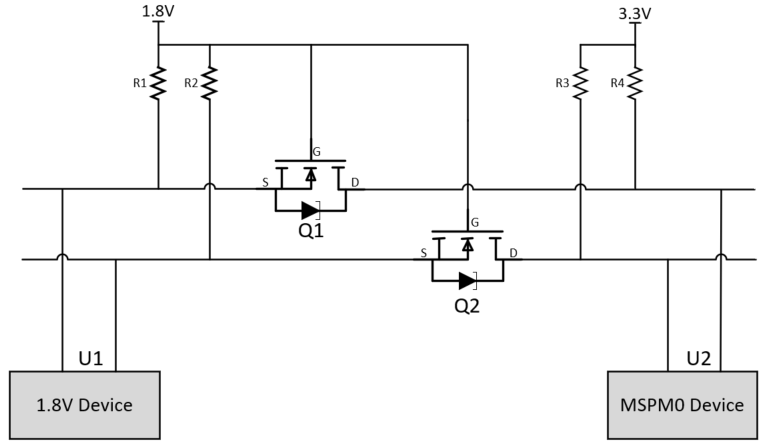SLAAE76B march 2023 – june 2023 MSPM0G1105 , MSPM0G1106 , MSPM0G1107 , MSPM0G1505 , MSPM0G1506 , MSPM0G1507 , MSPM0G3105 , MSPM0G3106 , MSPM0G3107 , MSPM0G3505 , MSPM0G3506 , MSPM0G3507
8.6 Communicate With a 1.8-V Device Without a Level Shifter
The MSPM0G series devices use a 3.3-V logic level (excluding ODIO). If you need to communicate with 1.8-V devices and do not use external level shifter devices, Figure 8-2 shows a suggested circuit for interfacing with a 1.8-V device.
 Figure 8-2 Suggested Communication Circuit With 1.8-V Device
Figure 8-2 Suggested Communication Circuit With 1.8-V DeviceTwo MOSFET are used in this circuit - check the VGS to ensure this MOSFET can fully turn on with a low RDS(on): for 1.8-V device, use less than 1.8-V VGS MOSFET. However, too low VGS MOSFET, can cause the MOSFET to turn on at a very small voltage (MCU logic judges it as 0), resulting in communication logic error.
U1 output and U2 input
- U1 output “1.8v high”, Q1 VGS around 0, thus Q1 turn off, U2 reads “3.3v high” with R4.
- U1 output “low”, Q1 VGS around 1.8v, thus Q1 turn on, U2 reads “low”.
U1 input and U2 output
- U2 output “3.3 V high”, U1 keep 1.8 V with R1, and Q1 turn off, thus U1 reads “1.8 V high”.
- U2 output “low”, U1 keep 1.8 V with R1 firstly, but the diode inside MOSFET will pull down U1 to 0.7 V (diode voltage drops), and then cause VGS to be greater than the turn-on voltage, Q1 turns on, and U1 reads "low".